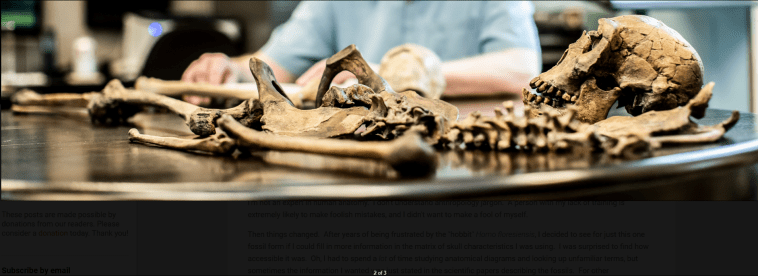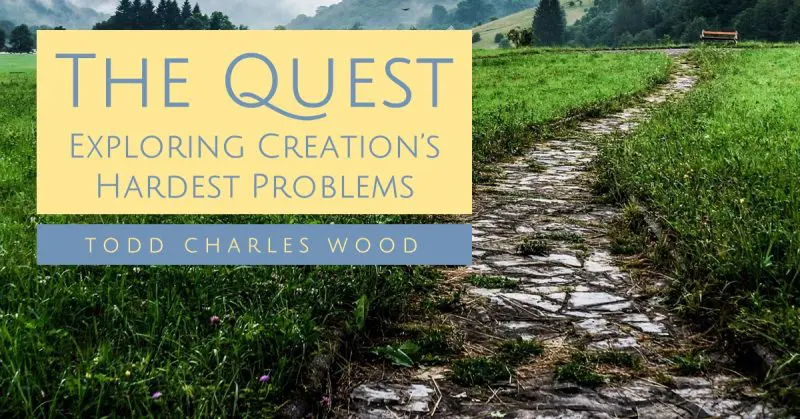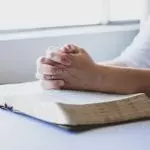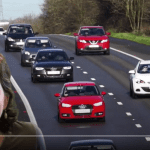[…and their extant counterparts. Originally published as Studying Skeletons]
Now that the International Conference on Creationism is over, let’s talk about skeletons.
I hardly know where to begin. I’ve spent three years now immersed in skeletons, slowly amassing the information I needed to assess the skeletal similarities of fossil hominins. For most of my career, I was just too intimidated to try this. I’m not an expert in human anatomy. I don’t understand anthropology jargon. A person with my lack of training is extremely likely to make foolish mistakes, and I didn’t want to make a fool of myself.
Then things changed. After years of being frustrated by the “hobbit” Homo floresiensis, I decided to see for just this one fossil form if I could fill in more information in the matrix of skull characteristics I was using. I was surprised to find how accessible it was. Oh, I had to spend a lot of time studying anatomical diagrams and looking up unfamiliar terms, but sometimes the information I wanted was just stated in the scientific papers describing the fossils. For other characteristics, measurements were published, and I could easily see that this thing was wider than it was tall. For still other characteristics, I could see them in high-resolution photographs of the original fossils. I added 55 pieces of information about H. floresiensis to my character matrix. I started to think, maybe this isn’t so impossible after all. Maybe I can do this?
Then the skeletons started to present themselves to me. One random night of googling led me to 3D scans of the upper limb bones of Feldhofer 1, the original Neandertal specimen. A little more persistence led me to scans of the leg bones, backbone, and ribs. Suddenly, I had 3D prints of a lot of elements of a composite Neandertal skeleton. Things kind of exploded from there.
Scans of Au. africanus bones from Sterkfontein popped up on Morphosource. I picked up a second generation cast of the Lucy skeleton and a second hand cast of Nariokotome. These bones I so needed to study were suddenly accessible to me.
Then God sent me a student. Peter was just in high school at the time, and I was really reticent to invest time in him. High school kids are just full of high school stuff and pulled in every direction imaginable, and I didn’t think he’d have the dedication needed to work on a research project with me. But he persisted and insisted, so I decided to at least give him a chance. My fears were very wrong. He was about as obsessed with hominin fossils as I am. And he has a better mind for trivia than I do. By the end of the project, I could ask him a random question like “Is there a navicular from Au. afarensis?” and he would not only tell me yes or no but name the specimen number. He was a blessing to work with. I hope we keep working together.
So that’s how it all started. I gained the confidence. I found the bones. And the Lord renewed my youthful enthusiasm by sending me an actual young person! So off we went.
Since no one had ever put together a set of skeletal characteristics of the type I imagined, we decided to start with published character lists from nine different papers published by actual anthropologists. We surveyed the different skeletons known and settled on which hominins we would include in our sample. We decided there was no good reason to exclude chimpanzee and gorilla as outgroup taxa, so we added them too. We went through the character descriptions and eliminated as much redundancy as we could find. Then we evaluated a number of skeletal characteristics on our own and added some characters of our devising.
Then came the big week. I was telling a friend at Southern Adventist University about our work, and she told me that they had chimpanzee and gorilla cast skeletons in their collection. So she set me up for a solid week at spring break with unfettered access to that material. I flew Peter in for the week. He brought his 3D prints of Au. sediba and H. naledi. I brought all of our skeletons, and we went to work. We went through the chimp and gorilla skeletons and filled in as much information as we could find.
Throughout that week, we evaluated most of the characters individually. Some we removed because we found they were still redundant. Some we replaced with new characters that focused on the same kind of trait. By the end of the week, we added almost 900 new pieces of information to our character matrix.
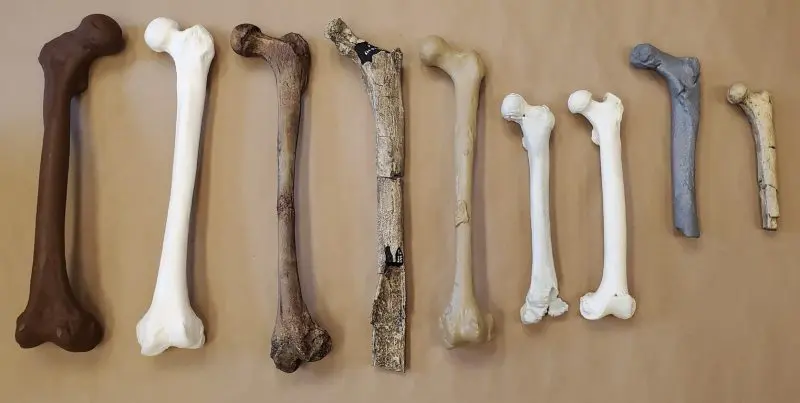
Now I’m going to gush like an amateur: the ability to lay out a bone from multiple fossil forms and to see the differences and similarities is extraordinary. Yes, every student who’s ever done this is thinking, “Duh.” But really. It’s amazing. To be able to hold the specimens, to examine the bumps and ridges and compare them to the written descriptions, the work just comes alive. It reminds me in a very small way of getting my Ph.D., where I learned the intricacies of biochemistry by engaging in biochemistry.
I’m not saying that I have a Ph.D. in anthropology or that I’ve done anything close to a Ph.D. in anthropology because that’s false and crazy and arrogant. But the vast difference between seeing these things and just reading about them is hard to describe.
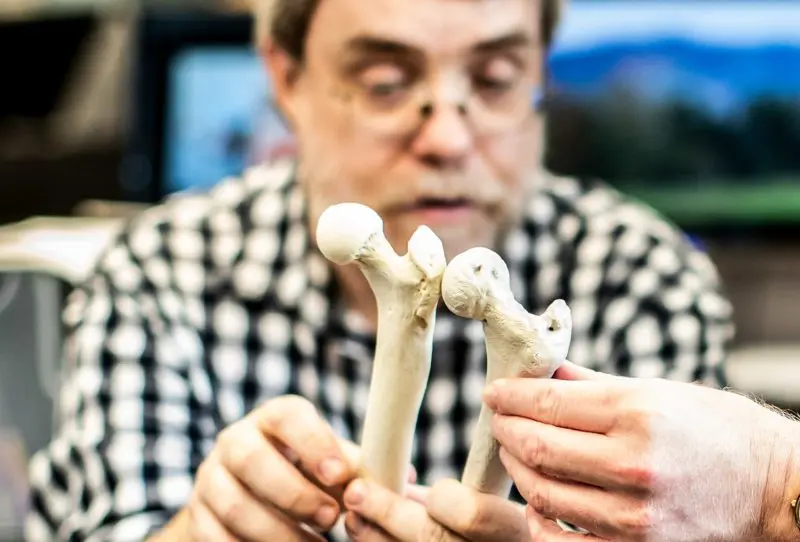
After that week, we kept working on revising the character descriptions and adding in new information. We assessed which characters needed attention, and we tracked down missing information and specimens. We started to think about how we were going to analyze the information that we gathered. How could we compare the skeletal characteristics to those of the skull, without biasing the result in one direction or the other? All through the process, we kept a regular schedule of weekly meetings to go over our progress and talk about the latest announcements and discoveries.
For our last big research push, we spent a couple of days at the Smithsonian to see if there were any additional characteristics we could get from the scan of Homo floresiensis on display. The collections were still closed to researchers at the time because of COVID, so we didn’t even try to schedule a visit there. From the public displays, we were able to fill in a few more pieces of information on H. floresiensis and also on Neandertals from their Shanidar 3 skeleton. During the evenings, we sat down with new casts and prints that we had acquired to fill in even more information.
This trip was really eye-opening to me. I visited the Smithsonian the summer before we started this project, mostly to take pictures of specimens in their display. During this visit, with two years of intimate evaluation of hominin fossils, I found myself a much more skeptical consumer of their displays. I could tell that some of the bones on display were sculptures because they didn’t match the photographs of the specimens I had on my phone. Other skeletons had been reconstructed in ways that didn’t make a lot of sense: the lumbar spine of Nariokotome is much too curved. I had become a much more careful consumer of their displays.
That’s good progress, I think.
I just got the final proofs on the paper from the ICC editor, so you’ll soon be able to read all about our work and results. I’ll definitely post an update when those papers are available. Meanwhile, I hope you’ve found my personal reflections to be enlightening. To everyone who has ever given anything to Core Academy, thank you for supporting this work. We couldn’t do it without you!
Have you read my book? You should check that out too!

